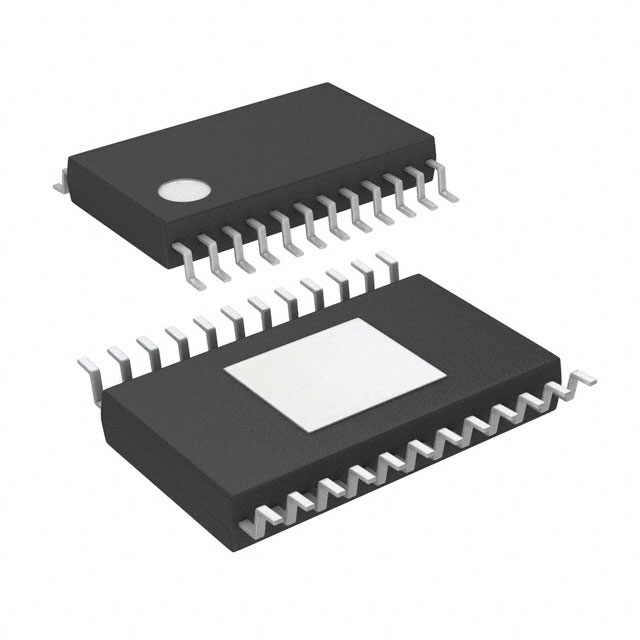LTC3862EFE-1#TRPBF
Product Overview
Category
The LTC3862EFE-1#TRPBF belongs to the category of integrated circuits (ICs) specifically designed for power management applications.
Use
This product is primarily used in various power management systems, including but not limited to voltage regulators, power converters, and battery charging circuits.
Characteristics
- High efficiency: The LTC3862EFE-1#TRPBF offers high conversion efficiency, ensuring optimal power transfer.
- Wide input voltage range: It can handle a wide range of input voltages, making it suitable for diverse applications.
- Fast transient response: This IC provides a fast response to sudden changes in load conditions, maintaining stable output voltage.
- Adjustable output voltage: The output voltage can be easily adjusted according to specific requirements.
- Protection features: The LTC3862EFE-1#TRPBF incorporates various protection mechanisms such as overvoltage, undervoltage, and overcurrent protection.
Package
The LTC3862EFE-1#TRPBF is available in a small form factor package, which enhances its suitability for space-constrained applications. The package type is FE, and it is provided in tape and reel packaging.
Essence
The essence of the LTC3862EFE-1#TRPBF lies in its ability to efficiently manage power in various electronic systems, ensuring stable and reliable operation.
Packaging/Quantity
This product is typically supplied in reels, with each reel containing a specified quantity of LTC3862EFE-1#TRPBF ICs.
Specifications
- Input Voltage Range: 4V to 38V
- Output Voltage Range: 0.8V to 5.5V
- Maximum Output Current: 20A
- Switching Frequency: Up to 2MHz
- Operating Temperature Range: -40°C to 125°C
Detailed Pin Configuration
The LTC3862EFE-1#TRPBF features a 24-pin package with the following pin configuration:
- VIN: Input voltage
- GND: Ground reference
- VCC: Power supply for internal circuitry
- SS/TR/UVLO: Soft-start, tracking, and undervoltage lockout control
- FB: Feedback voltage input
- COMP: Compensation node for loop stability
- RT/CLKOUT: External resistor for setting switching frequency or clock output
- SYNC/MODE: Synchronization input or mode selection
- PGND: Power ground
- SW: Switching node connection
- BOOT: Bootstrap capacitor connection
- LX: Inductor connection 13-16. NC: No connection
- VSENSE+: Positive input of current sense amplifier
- VSENSE-: Negative input of current sense amplifier
- ITH: Current limit threshold setting
- OCSET: Overcurrent protection threshold setting
- SS/TR/UVLO: Soft-start, tracking, and undervoltage lockout control
- VCC: Power supply for internal circuitry
- GND: Ground reference
- VIN: Input voltage
Functional Features
- Constant voltage (CV) and constant current (CC) operation modes
- Adjustable soft-start time
- Programmable switching frequency
- Overvoltage and undervoltage protection
- Overcurrent protection with adjustable threshold
- Thermal shutdown protection
Advantages and Disadvantages
Advantages
- High efficiency ensures minimal power loss
- Wide input voltage range allows for versatile applications
- Fast transient response maintains stable output voltage during load changes
- Compact package size suitable for space-constrained designs
- Comprehensive protection features enhance system reliability
Disadvantages
- Limited maximum output current of 20A may not be sufficient for high-power applications
- Requires external components for proper operation, increasing overall system complexity
Working Principles
The LTC3862EFE-1#TRPBF operates as a synchronous step-down DC-DC converter. It utilizes a pulse-width modulation (PWM) control scheme to regulate the output voltage. The input voltage is stepped down to the desired output voltage using an inductor and a power MOSFET. The feedback loop continuously adjusts the duty cycle of the MOSFET to maintain the output voltage within the specified range.
Detailed Application Field Plans
The LTC3862EFE-1#TRPBF finds applications in various fields, including: - Industrial power supplies - Automotive electronics - Telecommunications equipment - Portable electronic devices - Battery charging systems
Detailed and Complete Alternative Models
Some alternative models that offer similar functionality to the LTC3862EFE-1#TRPBF include: - LT8610ABEMSE#PBF - LT8645SIV#PBF -
Senaraikan 10 soalan dan jawapan biasa yang berkaitan dengan aplikasi LTC3862EFE-1#TRPBF dalam penyelesaian teknikal
Sure! Here are 10 common questions and answers related to the application of LTC3862EFE-1#TRPBF in technical solutions:
Q1: What is LTC3862EFE-1#TRPBF? A1: LTC3862EFE-1#TRPBF is a specific model number for a power management integrated circuit (PMIC) manufactured by Linear Technology (now part of Analog Devices). It is designed for use in various technical solutions.
Q2: What are the key features of LTC3862EFE-1#TRPBF? A2: Some key features of LTC3862EFE-1#TRPBF include high efficiency synchronous buck controller, wide input voltage range, adjustable output voltage, programmable soft-start, and overvoltage protection.
Q3: What is the typical application of LTC3862EFE-1#TRPBF? A3: LTC3862EFE-1#TRPBF is commonly used in applications such as industrial equipment, automotive systems, telecom infrastructure, and other power management solutions that require efficient voltage regulation.
Q4: What is the maximum input voltage supported by LTC3862EFE-1#TRPBF? A4: The maximum input voltage supported by LTC3862EFE-1#TRPBF is typically around 60V.
Q5: Can LTC3862EFE-1#TRPBF be used for step-down voltage conversion? A5: Yes, LTC3862EFE-1#TRPBF is specifically designed for step-down voltage conversion applications.
Q6: Does LTC3862EFE-1#TRPBF have built-in protection features? A6: Yes, LTC3862EFE-1#TRPBF includes various protection features like overvoltage protection, undervoltage lockout, and overcurrent protection.
Q7: What is the efficiency of LTC3862EFE-1#TRPBF? A7: The efficiency of LTC3862EFE-1#TRPBF can vary depending on the specific application and operating conditions. However, it is designed to provide high efficiency power conversion.
Q8: Can LTC3862EFE-1#TRPBF be used in battery-powered applications? A8: Yes, LTC3862EFE-1#TRPBF can be used in battery-powered applications as it supports a wide input voltage range and efficient power conversion.
Q9: Is there any evaluation board available for LTC3862EFE-1#TRPBF? A9: Yes, Analog Devices provides an evaluation board for LTC3862EFE-1#TRPBF, which can help users quickly prototype and test their power management solutions.
Q10: Where can I find more information about LTC3862EFE-1#TRPBF? A10: You can find more detailed information about LTC3862EFE-1#TRPBF, including datasheets, application notes, and technical support, on the Analog Devices website or by contacting their customer support team.
Please note that the answers provided here are general and may vary based on specific requirements and use cases. It is always recommended to refer to the official documentation and consult with experts for accurate and detailed information.


